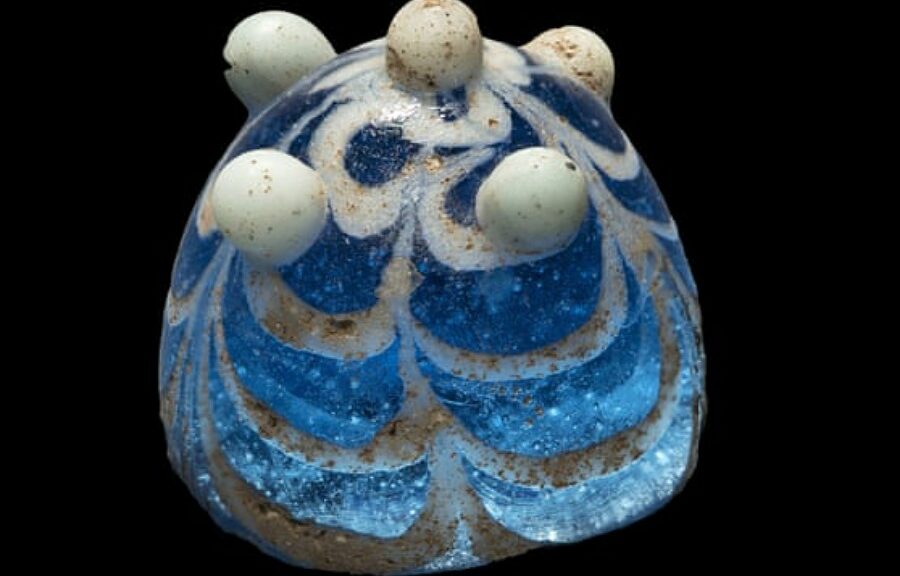Board-game piece from the period of first Viking raid found on Lindisfarne, England.
The first wave of Viking raids in England has announced a small glass crown as a rare archaeological artifact.
On the holy island of Lindisfarne, a tidal island located off the north-western coast of England in Northumberland, a small working glass artifact was uncovered.
The Times reports that historians claim the crown was gameplay from the hnefatafl (king’s table) games strategy board gamed in England, Ireland and Scandinavia, prior to the arrival of chess in the 12th century, made from spinning blue and white glass with green glass bobbles.
The relic, which is no bigger than a grape, is described as being “of exquisite workmanship” showing influence from across the North Sea and if it is indeed a hnefatafl gaming piece it is a rare archaeological treasure linking the English island with the Vikings at the beginning of a turbulent period in English and Scandinavian history.

The Holy Island of Lindisfarne is perhaps best known for the 8th century illuminated gospels manufactured in the island’s first monastery, but in 793 AD the island was sacked in what was the first major Viking raid in Britain or Ireland.
The newly discovered gaming piece, according to a report in the Guardian, is thought to have maybe been accidentally dropped by a Viking or owned by a “high-status local” imitating Norse customs. Regardless, the treasure offers archaeologists a hard link between Lindisfarne ’s Anglo-Saxon monastery and the Norse raiders that sacked it.
Dr. David Petts, the project’s lead archaeologist and senior lecturer in the archaeology of northern England at Durham University, said that while the exact location of the island’s early wooden monastery is not known, recent excavations on the island by archaeologists and volunteers from DigVentures have located a cemetery and a building.
DigVentures excavations on Lindisfarne are crowdfunded and greatly staffed by volunteers and this rare find was made last summer by the mother of one of the excavation teams who visited the site for a day celebrating her birthday.
Found in a trench dating to between the 8th and 9th centuries the gaming piece dates to around the time of the first Viking raid and according to DigVentures’ managing director, Lisa Westcott Wilkins, several of the most significant finds from Lindisfarne have been made by members of the public.
The “big argument”, says Wilkins, is whether you can do real archaeology with members of the public, but “you can” as long as it is properly supervised, she says.
When Wilkins was first presented with the tiny glass piece she says her “heart was pounding, the little hairs on my arms were standing up”, but as a scientist, she had trained herself out of having an emotional response to even such a fine piece, “it’s a piece of evidence, bottom line,” she said. But because the piece is “just so beautiful and so evocative of that time period,” the scientist said she just couldn’t help herself.

Dr. Petts said we often tend to think of early medieval Christianity, especially on islands, “as terribly austere: that they were all living a brutal, hard life” but this was not the case for everyone.
According to the archaeologist, even if it is proven the game this piece belonged to was being played by pilgrims or wealthy monks in the period before the Vikings raided, he says, it demonstrates that the influence of Norse culture had already extended across the Nordic regions.
Moreover, the professor says, in the 8th century Lindisfarne was “a bustling place peopled with monks, pilgrims, tradespeople, and even visiting kings,” and the sheer quality of this piece suggests someone on the island lived an elite lifestyle.

According to Anglo-Saxon writers, the opening weeks of the year 793 AD were worrying times in northern England with folk reporting whirlwinds, sporadic lightning, and even “fiery dragons flying in the air”.
And while in most years the preceding famine would have fulfilled the meaning of these prophetic signs, on June 8th darkness spread on England in the form of a fleet of heathens who appeared on the east horizon “and miserably destroyed God’s church on Lindisfarne, with plunder and slaughter”.
I have been careful not to call the Viking raid on the island of Lindisfarne, the first, but the “first major” attack on England, for only four years before, in 789 AD, according to English Heritage, “three ships of Northman had landed on the coast of Wessex, and killed the king’s reeve who had been sent to bring the strangers to the West Saxon court”.
But the assault on Lindisfarne differed greatly from this skirmish because it was a direct strike at the Christian sacred heart of the Northumbrian kingdom, desecrating what is known as “the very place where the Christian religion began” in England. It was where the venerated Cuthbert (d. 687) had served as a bishop and where his remains were worshiped as that of a saint.

The message delivered by the 793 AD raid was clear: we don’t just want your fields, fish, and women, but we are here to topple your king. And in this context no more fitting a discovery could ever have been made on Lindisfarne than an easily breakable crown.
